Remember sliding into those vinyl booths at your favorite diner, the jukebox humming in the background as you scanned a menu full of comforting classics? The restaurant landscape has undergone a remarkable transformation over the decades, with many once-standard offerings now either vanished or reinvented beyond recognition. Join us for a stroll down culinary memory lane as we explore the dishes that time (and changing tastes) have left behind.
1. Jellied Consommé
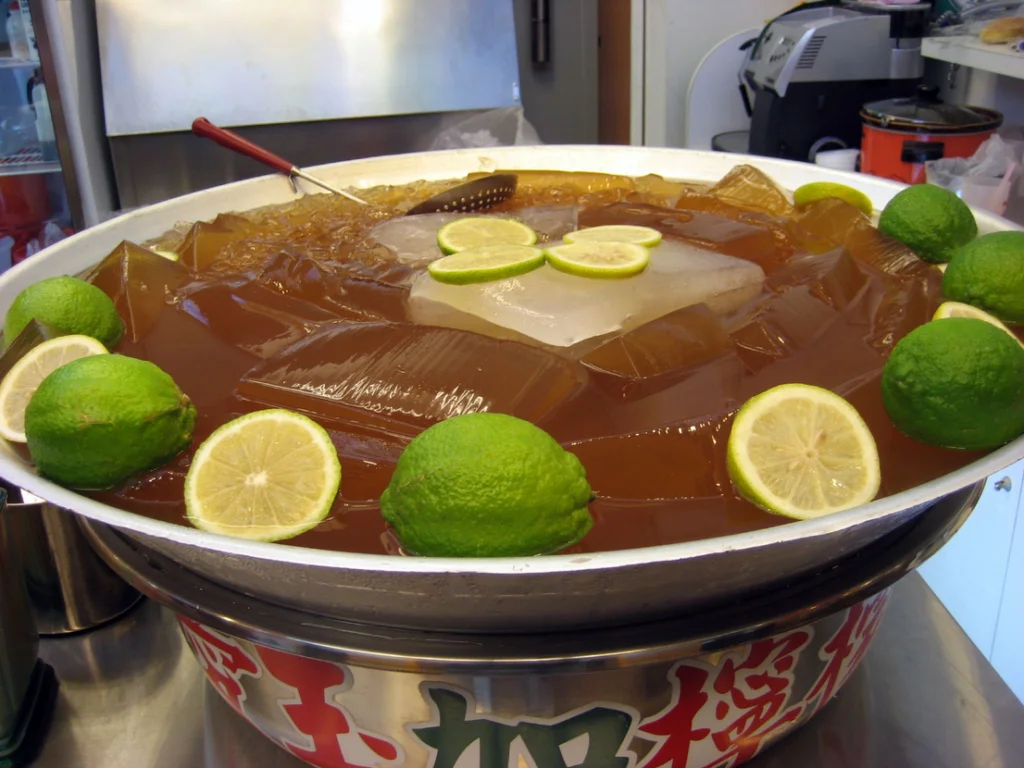
What once appeared on nearly every fine dining establishment’s appetizer section, jellied consommé was the epitome of sophistication in mid-century American restaurants. This clarified meat broth, chilled until it achieved a delicate, wobbling texture, was typically served in elegant crystal bowls with a squeeze of lemon and sprinkle of fresh herbs. Hostesses across America proudly displayed their consommé-making prowess at dinner parties, with cookbooks of the era dedicating entire chapters to perfecting this now-forgotten starter. Alta Journal sees this as proof of Jell-O’s timeless popularity across generations.
Today’s diners would likely recoil at the sight of what essentially appears to be meat-flavored Jell-O arriving at their table as a prestigious first course. The labor-intensive process of clarifying stock with egg whites and the changing American palate has relegated this once-ubiquitous appetizer to the culinary history books. Only the most dedicated retro establishments or experimental high-end restaurants might feature a modern interpretation, usually deconstructed or reimagined to appeal to contemporary sensibilities.
2. Chicken à la King

This creamy concoction of diced chicken, mushrooms, and pimientos in a rich sauce was the crown jewel of luncheons and dinner parties throughout the 1950s and 60s. Served over toast points, puff pastry shells, or rice, Chicken à la King represented accessible luxury for the growing middle class and appeared on countless restaurant menus across price points. The dish was so beloved that frozen food manufacturers rushed to create heat-and-serve versions, cementing its place in the pantheon of American comfort foods. Quaint Cooking cakes a bite out of this dish’s tasty history that’s as fancy as its name.
The rich, heavy cream sauce and subtle flavoring that once made this dish a staple have fallen out of favor in an era of bolder, more globally-influenced cuisine. Modern interpretations, when you can find them, typically feature lighter sauces, additional vegetables, and more pronounced seasoning to appeal to contemporary palates. What was once a go-to elegant entrée now appears dated and overly rich to younger generations who never experienced its heyday in banquet halls and country club dining rooms.
3. Tomato Aspic
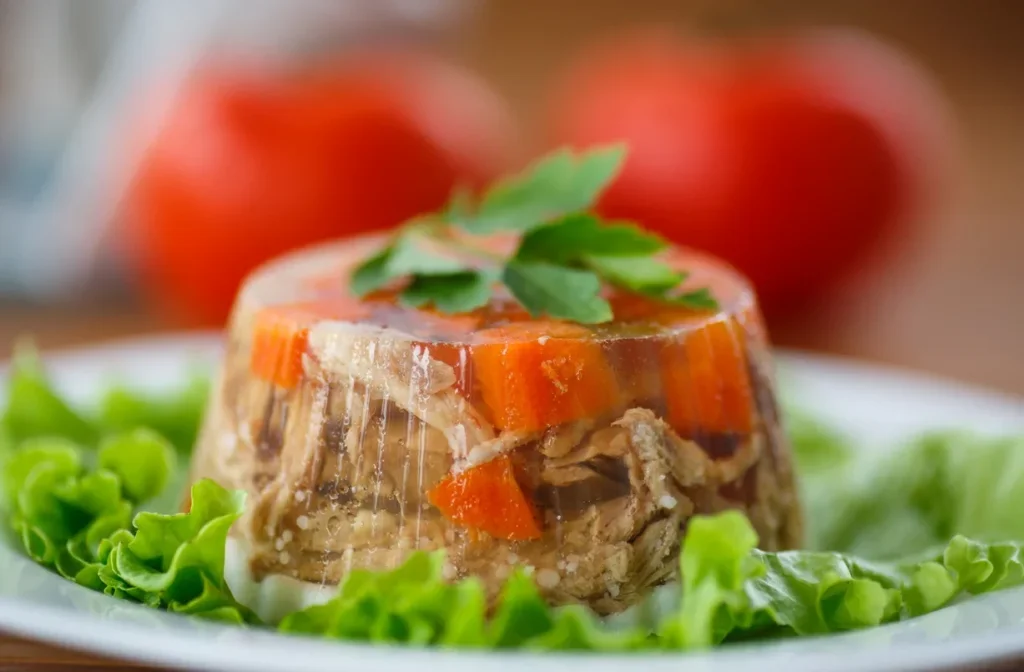
The sight of a molded tomato aspic, glistening atop a bed of lettuce, was once the pride of luncheon menus and ladies’ social gatherings across America. This savory gelatin creation, made from tomato juice, gelatin, and various seasonings, represented the height of culinary sophistication and modern food technology during the mid-20th century. Upscale restaurants and hotel dining rooms featured elaborate versions studded with olives, celery, and hard-boiled eggs, often served with a dollop of mayonnaise. As recounted by Southern Living, this particular dish was truly a product of history and the greater events that affected the world.
Today, the very concept of suspended vegetables in wobbly, savory gelatin elicits reactions ranging from puzzlement to outright disgust from younger diners. The textural combination that once represented elegance and entertaining prowess has become something of a retro joke, symbolic of outdated food trends. Only the most dedicated culinary historians or nostalgia-driven chefs dare to resurrect this once-standard offering, typically as a conversation piece rather than a serious menu contender.
4. Chipped Beef on Toast

Once a staple on breakfast and lunch menus across America, particularly in diners and casual restaurants, this humble dish of dried beef in white sauce over toast sustained generations. Military veterans will recognize it by its less polite nickname “S.O.S.” (a term we’ll leave to your imagination), as it was a standard offering in mess halls throughout multiple wars. Home cooks embraced the economical dish during leaner times, with recipe cards for creamed chipped beef passing through generations of family kitchens.
The dried beef product that forms the foundation of this dish has become increasingly difficult to find outside specialty shops, and its high sodium content doesn’t align with contemporary dietary concerns. Modern restaurants might offer updated versions with fresher ingredients and artisanal bread, but they bear little resemblance to the utilitarian plate that sustained the Greatest Generation. What was once comfort food for millions has become a curious relic, recognized primarily by those with memories of its heyday or historical interest in mid-century American cuisine.
5. Beef Wellington Individual Portions

Once the pinnacle of continental cuisine elegance, individual Beef Wellington portions graced the menus of high-end restaurants as their signature showstopper dish. These perfectly portioned filets, wrapped in pâté, duxelles, and encased in golden puff pastry, represented the epitome of fine dining craftsmanship and European influence. Tableside presentation of these immaculate parcels, often accompanied by a rich Madeira sauce, was dinner theater at its finest during the restaurant boom of the 1960s and 70s.
Today’s versions bear little resemblance to these meticulously crafted individual portions, with most establishments opting for the less labor-intensive full tenderloin preparation when they offer it at all. The elaborate preparation time, expensive ingredients, and changing dining patterns have rendered the individual Wellington nearly extinct in modern restaurants. When found today, it’s typically reimagined with contemporary ingredients like truffle oil or balsamic reductions that would be unrecognizable to diners of the Kennedy era.
6. Steak Diane
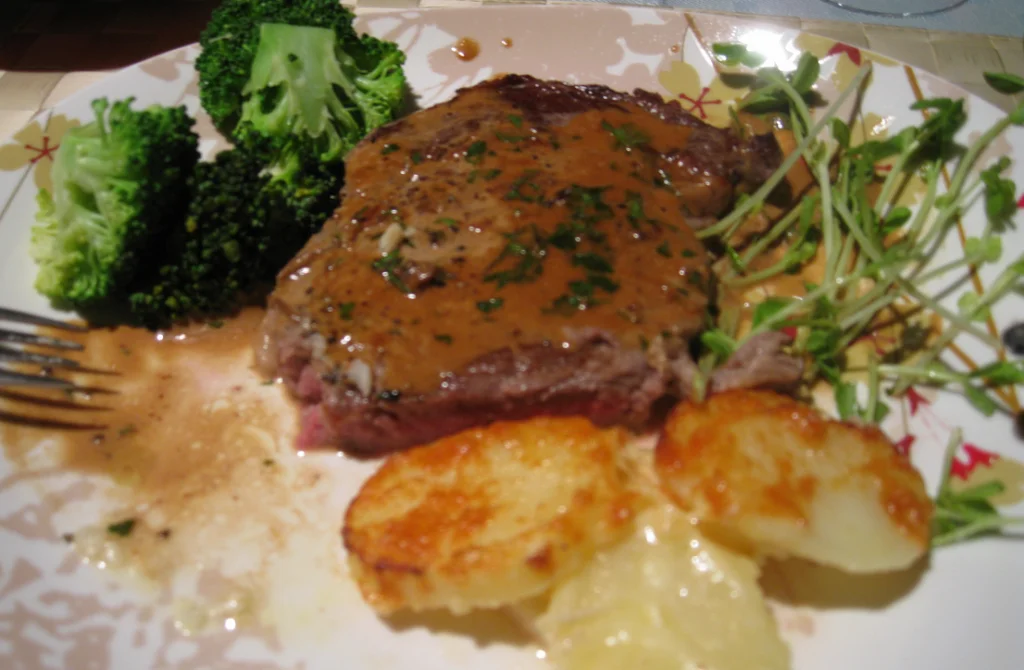
The dramatic tableside preparation of Steak Diane—with its theatrical flambé finish—was once the highlight of upscale dining experiences across America. Thin-pounded beef steaks quickly cooked in butter and finished with a sauce of pan juices, cream, and flamed brandy captivated diners who equated continental cuisine with sophistication and worldliness. The personal attention from tuxedoed waiters who prepared this dish just steps from your table represented the pinnacle of service and showmanship in fine dining establishments.
The liability concerns, changing service models, and demise of formal tableside preparation have rendered authentic Steak Diane virtually extinct in modern restaurants. Contemporary interpretations, when available, typically arrive fully prepared from the kitchen, missing the essential theatrical element that made the dish memorable. What once symbolized a special night out has been replaced by open kitchens and chef’s tables—different ways of making dining an interactive experience for a new generation.
7. Chicken Croquettes
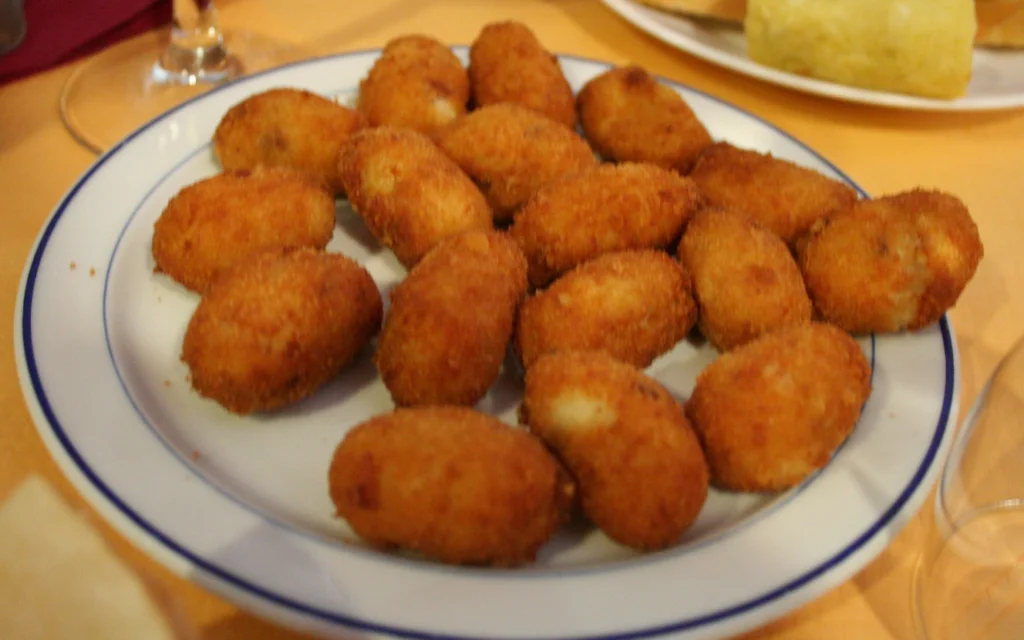
Shaped into perfect cones or cylinders and fried to golden perfection, chicken croquettes were a testament to resourcefulness and culinary skill on mid-century restaurant menus. These creamy interior, crispy exterior delights made use of leftover chicken transformed into an elegant offering through technique and presentation. Department store tea rooms and hotel restaurants particularly championed these sophisticated yet accessible creations, typically served with a delicate sauce and vegetable accompaniment on china plates.
Today’s sustainability-minded kitchens might celebrate the waste-reducing concept behind croquettes, but the execution and presentation have evolved dramatically. Modern versions tend to be smaller, more intensely flavored, and served as appetizers or small plates rather than main courses. The refined, subtle flavoring and formal presentation that characterized the original has given way to bolder spices and casual service styles—making the classic chicken croquette nearly unrecognizable to those who remember their heyday.
8. Teriyaki Steak with Pineapple Ring

No 1970s steakhouse menu was complete without the exotic allure of teriyaki steak crowned with a grilled pineapple ring and maraschino cherry. This entree represented America’s growing fascination with international flavors, particularly from the Pacific, following increased travel and cultural exchange. The sweet-savory combination and colorful presentation made this dish a special occasion favorite that balanced familiarity with just enough adventure for mainstream diners.
Contemporary Asian-fusion restaurants would hardly recognize this Americanized interpretation of Japanese flavors with its honey-thick sauce and canned fruit garnish. Today’s teriyaki preparations feature more authentic ingredients, less sweet profiles, and complex layering of umami flavors that would be foreign to diners who enjoyed the original version. What was once considered sophisticated international cuisine now appears as a quaint reminder of America’s culinary evolution and growing global awareness.
9. Ambrosia Salad as a First Course
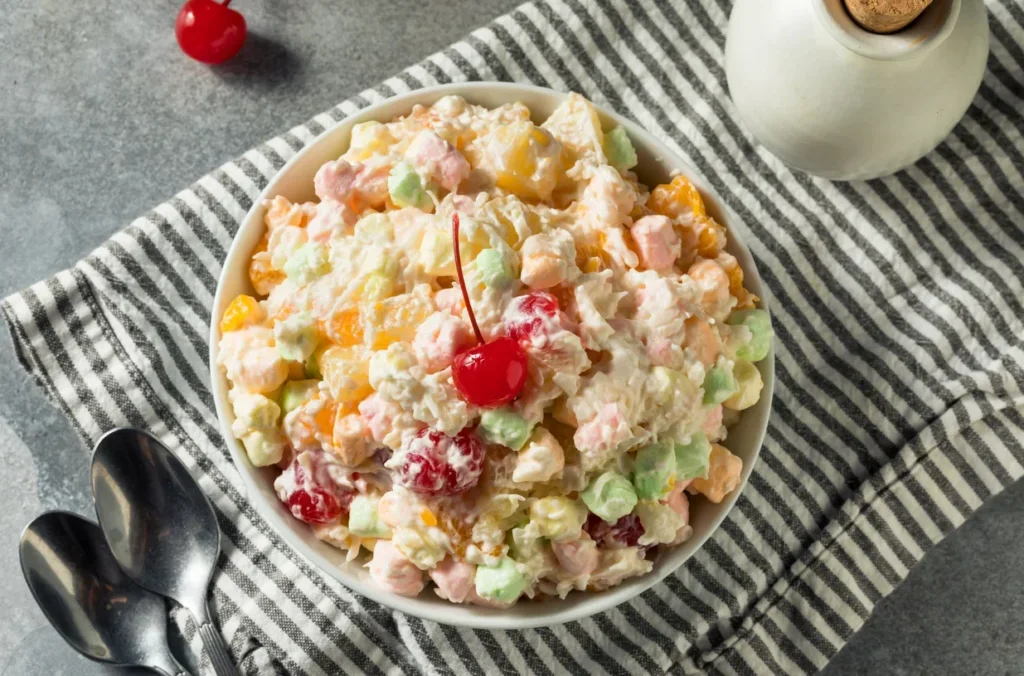
Once proudly displayed on restaurant menus as a refreshing first course or side dish, ambrosia salad combined canned fruits, coconut, miniature marshmallows, and sometimes sour cream or whipped topping. This colorful creation graced restaurant salad bars, holiday buffets, and everyday family menus as a sophisticated yet accessible dish that brightened any meal. Children and adults alike delighted in this sweet starter that somehow qualified as a salad despite its dessert-like qualities.
The very idea of serving marshmallows and canned fruit as a serious course in a meal seems bewildering to contemporary diners focused on fresh, seasonal ingredients. Modern interpretations, when they appear at all, typically reimagine ambrosia as a nostalgic dessert rather than a legitimate course in a proper meal. What was once a perfectly acceptable start to dinner at restaurants across America now exists primarily as a retro curiosity at potlucks or nostalgic holiday gatherings.
10. Baked Alaska
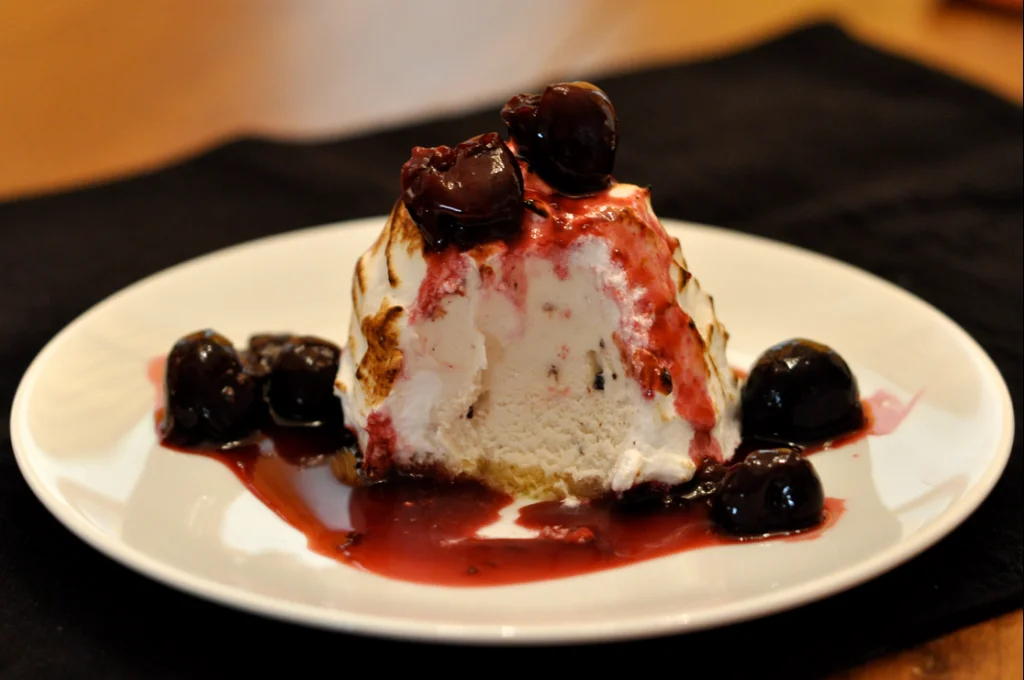
The spectacle of Baked Alaska—ice cream encased in meringue and briefly baked to create a showstopping temperature contrast—once represented the ultimate finale to fine dining experiences. This technical marvel, often wheeled out on dessert carts and sometimes flambéed tableside, demonstrated the pastry chef’s mastery and the restaurant’s commitment to memorable dining theater. Cruise ships, high-end restaurants, and special occasion venues featured this dramatic dessert that combined spectacle with scientific precision.
Today’s dessert menus favor individual portions, deconstructed classics, and global flavor influences that make traditional Baked Alaska seem overly elaborate and dated. The few modern versions that exist typically arrive as pre-portioned slices rather than the impressive domed presentation that made the original so memorable. What once symbolized celebration and culinary showmanship has largely disappeared, replaced by desserts that prioritize intense flavors and camera-ready presentation for social media sharing.
11. Welsh Rarebit
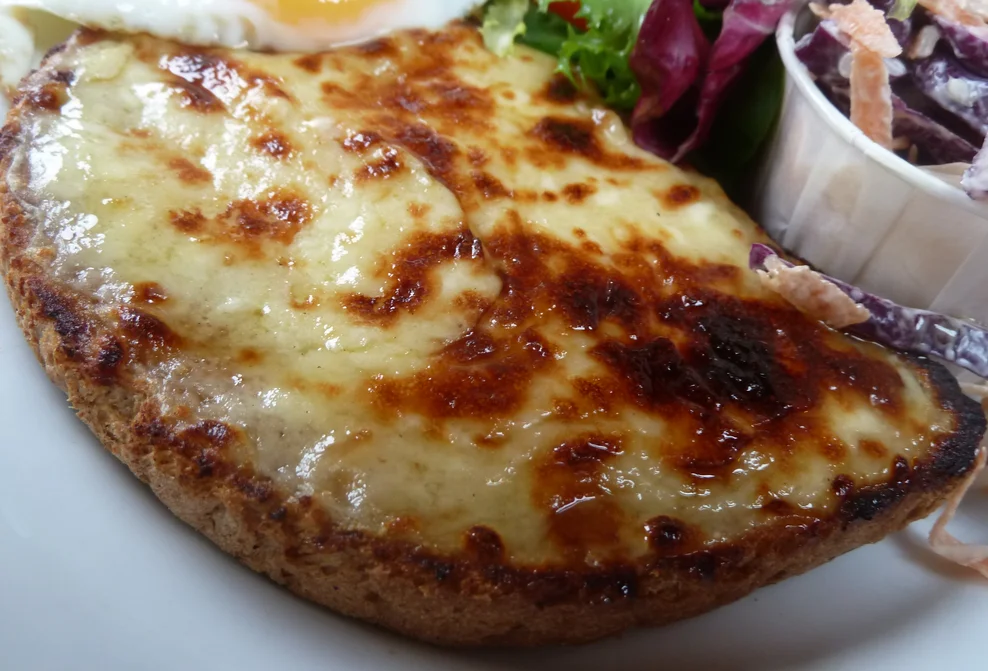
Once a staple on lunch menus across America, Welsh Rarebit showcased a rich cheese sauce luxuriously poured over toasted bread—a dish that transcended its humble ingredients through technique and presentation. Department store tea rooms, hotel restaurants, and upscale diners featured this comforting offering as a sophisticated light meal, often accompanied by a small salad or cup of soup. The signature sauce, typically featuring aged cheddar, beer, mustard, and Worcestershire, required careful attention to achieve the perfect consistency—neither too thick nor too runny—demonstrating the chef’s skill with classic techniques.
Contemporary versions of this once-ubiquitous dish have largely been replaced by simplified cheese toasts or transformed into elaborate gastropub fare bearing little resemblance to the original. Today’s interpretations often incorporate artisanal sourdough, craft beer reductions, and imported cheeses that would bewilder diners from the mid-century era who enjoyed this classic. What was once considered refined comfort food now appears either as an obscure culinary curiosity or has been reinvented as “elevated toast”—part of the modern brunch phenomenon that bears only a passing resemblance to its distinguished predecessor.
12. Cherries Jubilee
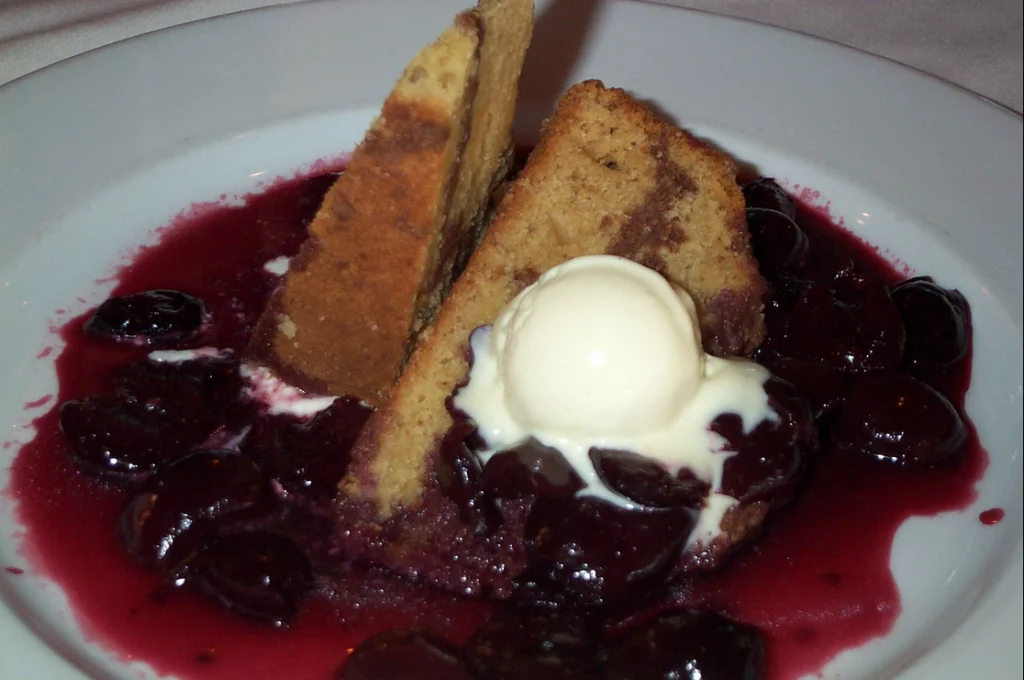
No special occasion dinner was complete without the theatrical tableside preparation of Cherries Jubilee—a dessert that combined spectacle with sophisticated flavor. This classic featured dark sweet cherries in a sauce of sugar and kirsch, dramatically flamed before being spooned over vanilla ice cream while diners watched in appreciative silence. Fine dining establishments trained their staff in the precise timing required to achieve the perfect blue flame that would impress guests without setting off sprinkler systems—a skill that separated experienced waiters from novices.
The liability concerns, changing service models, and evolution of dessert preferences have rendered traditional Cherries Jubilee performances nearly extinct in contemporary restaurants. Modern dessert menus favor complex plated creations with multiple components rather than the tableside drama that made dining out an occasion in previous decades. The simple yet elegant combination of warm cherries and cold ice cream that once symbolized celebration has given way to deconstructed, reimagined sweets designed more for Instagram than the immersive dining experiences of yesteryear.
The restaurant experience has always reflected broader cultural shifts, technological advances, and changing tastes—making menus fascinating time capsules of American life. While some might look back with rose-tinted nostalgia at these vanished classics, others might appreciate how far our collective palate has evolved. Either way, these dishes represent more than just food; they capture moments in our shared cultural history, telling stories of who we were and how we gathered around tables together through the decades.


